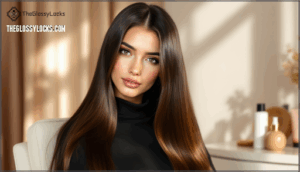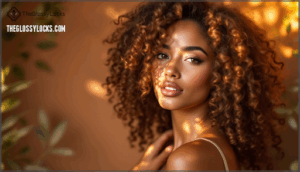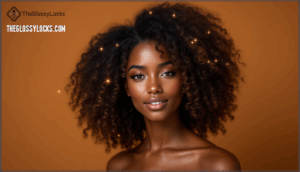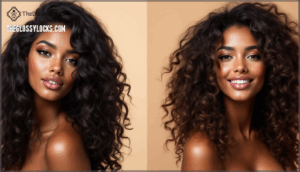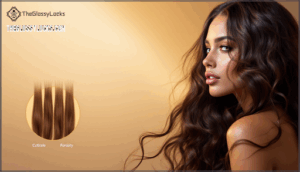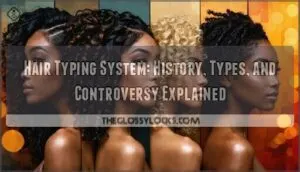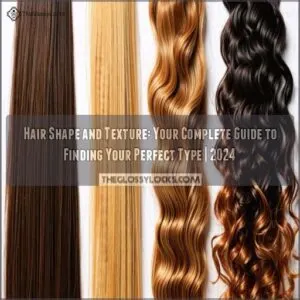This site is supported by our readers. We may earn a commission, at no cost to you, if you purchase through links.

Your curl pattern tells part of the story—texture, porosity, and density complete it. Most people misidentify their hair type because they’re looking at the wrong variables or relying on products that temporarily alter their natural structure.
Understanding these classification frameworks transforms your approach from guessing what might work to diagnosing what will work, based on your hair’s actual biological characteristics.
Table Of Contents
- Key Takeaways
- Hair Type Classification Systems
- Key Hair Type Categories
- Hair Texture and Thickness Classification
- Understanding Hair Density and Porosity
- Practical Tips for Identifying Your Hair Type
- Frequently Asked Questions (FAQs)
- What is hair type?
- What is the condition of hair loss?
- How many types of hair types are there?
- What is a hair type chart?
- How are hair strands classified?
- What is a type 1 hair?
- How often should I reclassify my hair type?
- Can hair type change with hormonal shifts?
- Do mixed hair textures require specialized care?
- How accurate are online hair typing tests?
- Conclusion
Key Takeaways
- Most people misidentify their hair type because they rely on curl pattern alone, ignoring the three-dimensional interplay of texture, porosity, and density—the biological trinity that actually determines which products will work and which styling techniques will fail.
- Hair classification systems like Andre Walker’s four-type framework provide diagnostic precision only when combined with tactile strand assessment, porosity testing, and density measurement, transforming your routine from guesswork into evidence-based care.
- Coarse Type 4C hair and fine Type 2A waves can share identical porosity levels despite opposite curl patterns, proving that surface-level typing misses the structural characteristics that govern moisture absorption, frizz control, and product penetration.
- Your hair type isn’t static—hormonal shifts, chemical treatments, environmental damage, and aging all alter density, porosity, and elasticity over time, requiring periodic reclassification to maintain an effective care protocol.
Hair Type Classification Systems
Understanding your hair starts with knowing which classification system to use. The two most recognized frameworks are the Andre Walker System and the L’Oréal Curl Meter, though other methods exist to help you identify your specific type.
Each system approaches hair differently, giving you multiple ways to pinpoint exactly what you’re working with.
Andre Walker Hair Typing System
Introduced in 1999 by celebrity stylist Andre Walker, this classification system revolutionized how we grasp hair by breaking down the complexity of curls into four primary types—straight, wavy, curly, and coily—each with subcategories that capture the nuances of diameter and pattern.
You’ll find your hair’s identity within these classifications:
- Type 1: Straight strands that fall without bends
- Type 2: Wavy hair forming loose "S" curves
- Type 3: Defined curls creating spirals
- Type 4: Tight coils with "Z" patterns
This hair typing framework helps you select products customized to your curl patterns and hair texture, though it’s just one piece of understanding your complete hair porosity and classification profile.
L’Oréal Curl Meter System
While the Andre Walker System maps hair into four foundational types, the L’Oréal Curl Meter System takes a more quantitative approach by measuring curl diameter with precision instruments. This gives researchers and product developers exact numerical data to work with instead of relying on visual assessment alone.
This hair curve analysis uses specialized curl meter tools to capture precise measurements of your curl pattern, translating your hair texture into mathematical values that inform L’Oréal products formulation.
You’ll benefit from this quantitative classification because it removes guesswork, providing standardized data that considers both curl diameter measurement and hair porosity levels for truly personalized care.
Other Popular Classification Methods
Beyond L’Oréal’s measurement tools, you’ll find several hair type classification frameworks that challenge traditional curl-based systems. The LOIS Method examines strand patterns as L-shaped angles, O-shaped coils, I-shaped flat sections, or S-shaped bends, focusing on geometric characteristics rather than ethnicity. Fia’s System combines curl definition with strand thickness and texture, allowing multidimensional hair classification.
Geometric Systems use curve diameter and curl index for objectified grouping, while Materials Science approaches like Gaines-Page apply contour length ratios through microscopy. The Irizarry Scale introduces quantitative survey methods, revealing that individuals often struggle with self-assigning hair texture in tightly coiled categories.
Understanding hair typing systems is essential for determining the best hair care methods.
Key Hair Type Categories
Now that you understand the classification systems, let’s break down what each hair type actually looks like.
The four main categories—straight, wavy, curly, and coily—form the backbone of hair typing, and recognizing where your hair fits unlocks everything from product choices to styling techniques.
Here’s what sets each type apart.
Type 1 (Straight Hair)
Type 1 hair is the straightest of all hair types, drying without any natural bends, waves, or curls along the shaft. This hair texture lies completely flat against your scalp, reflecting light exceptionally well due to its smooth cuticle structure.
Within the straight hair classification, you’ll find three subcategories:
- Type 1A: Fine hair with minimal volume and body
- Type 1B: Medium-textured straight hair with moderate thickness
- Type 1C: Coarse, thicker straight strands with natural volume
For straight hair care, avoid heavy serums that weigh down fine hair tips, and consider dry shampoo for oil management in your hair straightening routine.
Type 2 (Wavy Hair)
Your hair forms that distinctive ‘S’ shape as it dries—a natural bend that falls somewhere between the sleek flatness of straight strands and the spiraled coils of truly curly hair.
Type 2 wavy hair breaks down into three subcategories: 2A features loose wave patterns with fine texture, 2B shows more defined S wave texture with moderate body, and 2C displays tighter waves approaching curl territory.
Understanding your hair porosity matters here—wavy hair products should amplify your natural hair wave patterns without weighing down movement or creating frizz.
Type 3 (Curly Hair)
When you brush through those loops and spirals—feeling them spring back against your fingers—you’re touching the essence of Type 3 curly hair, where defined curl patterns become your natural signature.
This hair type forms distinct loops and spirals, classified into three subcategories based on curl tightness: 3A shows loose, wide curls; 3B features springy, medium-diameter ringlets; and 3C displays tight, corkscrew coils.
Your hair texture and density influence how you approach curly hair care—moisture-rich products amplify curl definition without disrupting your natural curl pattern.
Type 4 (Coily Hair)
Coily hair—those tight, zigzagging strands that defy gravity and shrink up to 75% of their actual length—represents the most textured classification in the hair typing spectrum, demanding specialized understanding of its unique structural characteristics.
Type 4 coily hair subdivides into three distinct categories based on hair coil patterns and density:
- 4A forms tight, springy "S" curls
- 4B creates sharp-angled "Z" patterns
- 4C displays minimal definition with maximum shrinkage
- Each requires moisture-rich coily hair products
Coily texture tips emphasize hydration—your hair porosity and density determine which afro hair styling techniques work best for maintaining defined coils without breakage.
Hair Texture and Thickness Classification
Beyond curl pattern alone, your hair’s texture and thickness shape how it behaves and what it needs. These characteristics work hand-in-hand with your type number to give you the full picture.
Here’s how to identify where your strands fall on the texture spectrum.
Fine, Medium, and Coarse Hair Types
Beyond the visible curl pattern that defines your hair type, there’s an equally important dimension hiding in plain sight—the actual diameter of each individual strand.
Hair Texture Analysis breaks down into three distinct classifications: fine hair (Type A), which feels almost imperceptible when rolled between your fingers; medium hair (Type B), offering slight resistance to touch; and coarse hair (Type C), providing substantial tactile feedback.
This Hair Thickness Measurement fundamentally shapes how your strands respond to styling products and environmental factors.
Assessing Hair Texture by Touch
The simplest diagnostic tool for determining your hair’s texture lives at the tip of your fingers—no microscope required. This Tactile Assessment, known as the Hair Feel Test, relies on sensory feedback rather than visual inspection.
Here’s your three-step Texture Analysis protocol:
- Isolate a single strand from your scalp, preferably one that’s recently shed
- Roll the strand firmly between your thumb and forefinger, noting resistance
- Evaluate the sensation: imperceptible equals fine (Type A), slight resistance indicates medium (Type B), substantial feedback confirms coarse (Type C)
This Strand Evaluation method accurately determines hair texture regardless of your curl pattern or hair density.
Rolling Strand Method for Texture
You’ve likely performed the basic touch test, but mastering the Rolling Strand Method transforms that simple motion into a precise diagnostic technique.
Apply consistent pressure as you execute the Finger Roll—coarse strands (Type C) create noticeable friction and resistance, while fine hair (Type A) nearly disappears between your fingertips.
This Strand Test remains your most reliable tool for Texture Classification, cutting through the confusion of Hair Porosity and Density variables that often complicate Hair Type Classification.
Understanding Hair Density and Porosity
Density and porosity aren’t just technical terms—they’re the keys to understanding how your hair actually behaves. Measuring these traits gives you a clearer picture of what products work and why some styling techniques fall flat.
Let’s break down how to assess each one and what they reveal about your hair’s true nature.
Measuring Hair Density
Density determines how many hair strands grow per square inch of your scalp, and measuring it reveals whether you’re working with a sparse canvas or a lush forest. The Ponytail Method offers a quick circumference test—gather your hair and measure around:
- Less than 2 inches indicates low density, sparse strand count
- 2-3 inches signals medium density, moderate hair volume
- 4+ inches confirms high density, abundant hair formation
- Part hair with a comb to visually assess scalp visibility for density measurement
Determining Hair Porosity
Porosity measures your hair’s thirst—how readily each strand opens up to drink in moisture or stubbornly keeps it locked out. The Float Test reveals water absorption patterns: drop a clean strand in a glass and watch.
If it sinks quickly, your hair cuticles are highly porous, greedily accepting product penetration. If it floats stubbornly, you’re dealing with low porosity that resists moisture—critical intel for your hair type classification system.
Impact of Density and Porosity on Classification
Understanding both density and porosity transforms your hair type classification system from surface-level guesswork into diagnostic precision. High-density, low-porosity hair creates fuller, shinier appearances—classic straight or wavy profiles—while low-density, high-porosity strands appear thinner with compromised frizz control and curl definition.
Your hair health depends on recognizing this interplay: environmental wear raises porosity levels over time, regardless of native hair texture and formation, while age decreases density approximately 0.33 hairs/cm² annually—making elasticity assessment and individualized care protocols non-negotiable.
Hair ages naturally—environmental damage increases porosity while density drops 0.33 hairs/cm² yearly, demanding tailored care beyond basic texture typing
To better manage hair, consider learning about hair porosity types to create a tailored hair care regimen.
Practical Tips for Identifying Your Hair Type
Identifying your hair type doesn’t have to feel like guesswork. You’ll need a few simple methods to assess your curl pattern, texture, and density with accuracy.
Here’s how to avoid common classification errors and get a clear picture of what you’re really working with.
Using Hair Type Charts and Guides
Hair type charts can be your quickest path to understanding what’s actually happening on your head, cutting through the confusion when mirror glances and finger tests leave you second-guessing. Most hair type classification systems include visual guides showing curl pattern analysis from straight to coily textures, paired with texture assessment tools that help you identify fine, medium, or coarse strands and porosity testing methods to determine moisture absorption.
Analyzing Curl Patterns and Thickness
Curl patterns don’t exist in isolation—they’re intrinsically linked to strand thickness, and reading both together reveals the complete story of your hair’s characteristics, moisture needs, and styling potential. When you’re analyzing curl pattern and hair texture simultaneously, you’ll notice how fine coils need lighter products than coarse waves, even though their curl definition appears worlds apart.
Key observation points for accurate texture variation assessment:
- Watch how your hair dries naturally—tight curl patterns with fine texture create delicate spirals, while coarse strands form sturdy, defined shapes with better frizz control
- Test hair elasticity by gently stretching a strand; thicker hair resists more, directly affecting how curl definition holds throughout the day
- Note moisture absorption speed—fine curls drink up product quickly, coarse hair takes longer, regardless of hair type classification
Common Mistakes in Hair Type Classification
Visual Bias leads classification errors every time you judge hair type under product influence or styled conditions. Product influence distorts natural texture characteristics, making hair texture characteristics appear different than they actually are.
Studies reveal curl overlap across systems, with identical samples fitting multiple categories due to inconsistent measurement standards.
Porosity issues complicate understanding hair types further—high porosity often stems from damage, not curl pattern alone, yet most charts ignore this structural factor entirely.
Frequently Asked Questions (FAQs)
What is hair type?
Picture follicle structure as a fingerprint—each strand tells its own genetic story. Hair type defines your hair’s natural texture and characteristics, including curl pattern, thickness, and porosity.
These factors stem from follicle structure and hair genetics, influencing growth and scalp health throughout your life.
What is the condition of hair loss?
Hair loss represents a disruption in the hair growth cycle, where follicle damage or scalp health issues lead to hair thinning, excessive hair breakage, or balding patterns.
Understanding the underlying causes facilitates targeted approaches for hair regrowth and restoring hair health.
How many types of hair types are there?
Think of hair texture like fabric—some materials feel smooth, others thick and textured. There are four primary hair types in classification systems: Type 1 (straight), Type 2 (wavy), Type 3 (curly), and Type 4 (coily), each with subcategories based on curl patterns and texture characteristics.
What is a hair type chart?
A chart acts as a visual reference tool that maps out the different hair categories—from straight to coily—alongside texture classifications and porosity levels.
This helps you decode your unique hair characteristics through structured hair typing systems and texture analysis, enabling better product choices.
How are hair strands classified?
Trichologists classify individual hair strands through texture classification and strand thickness assessment. By rolling a single strand between your fingers, you can determine if your hair follicle produces fine (type A), medium (type B), or coarse (type C) fibers—each affecting how your curl pattern manifests.
What is a type 1 hair?
Type 1 hair falls into the straight hair category, drying without bends, curls, or waves. This silky texture lies flat against your scalp, reflecting light easily.
Fine hair tips matter here—straight hair care requires lightweight products to avoid weighing down strands, maintaining smooth styling and natural movement.
How often should I reclassify my hair type?
You’ll want to reassess your hair type classification whenever significant lifestyle factors shift—think major hormonal changes, chemical treatments causing hair damage, or noticeable seasonal changes affecting your hair’s texture.
Hair growth cycles and evolving hair care routines also signal reclassification tips matter.
Can hair type change with hormonal shifts?
Yes, your hair can shift with hormonal changes. Pregnancy effects, menopause impact, and thyroid influence all affect hair texture types and thickness.
Hormone regulation directly impacts hair health factors, including porosity and elasticity, sometimes reclassifying your entire profile.
Do mixed hair textures require specialized care?
Mixed Texture Hair Blending demands Product Layering strategies customized to each zone’s Curl Definition needs.
You’ll need Frizz Control techniques that respect varying porosity levels, applying lighter formulas where strands resist moisture and richer treatments where coils crave hydration.
How accurate are online hair typing tests?
Here’s the thing—digital tools aren’t a crystal ball. Online quizzes for hair typing can miss the mark on test reliability, especially since hair analysis requires examining porosity and elasticity, texture nuances, and curl patterns that accuracy factors like lighting or product buildup easily distort beyond a screen’s reach.
Conclusion
Here’s the unexpected truth: most people discover their actual hair type classification only after years of product failures—the moment their curl pattern emerges from chemical buildup, or their porosity reveals itself through dye damage. Your strands were always speaking this language; you just needed the framework to translate it.
Armed with these systems—Andre Walker’s types, texture analysis, porosity tests—you’re no longer guessing. You’re diagnosing. And that shift from confusion to clarity? That’s when your hair routine stops fighting your biology and starts working with it.
- https://www.laylakays.com/blogs/blog/textured-tresses-worldwide-celebrating-the-global-diversity-of-hair
- https://pubmed.ncbi.nlm.nih.gov/36374002/
- https://www.curlsbot.com/blog/the-science-of-hair-typing
- https://digitalcommons.wayne.edu/humbiol/vol79/iss3/1/
- https://pmc.ncbi.nlm.nih.gov/articles/PMC5886212/

